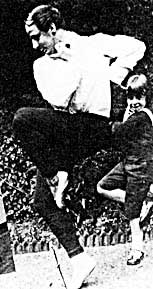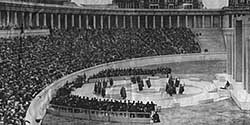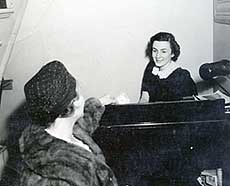
Mikhail and Vitale Fokine, 1937 - 1939
During the recital work at Sarah Horlick’s, Gladys got very thin, and my parents were so concerned about her health that they sent her to the Cape, to Manamut. She stayed by herself in Manamut, in a little inn. One day while she was on the beach, she met another gal, Louise, a little older then herself.  They got to talking and Louise told Glady that her fiancée was Vitale Fokine, the son of Mikhail Fokine, who was the great Russian choreographer – Sylphides, Scheherazade... Vitale was running the ballet school while his father was travelling around teaching his ballets to the different companies in New York.
They got to talking and Louise told Glady that her fiancée was Vitale Fokine, the son of Mikhail Fokine, who was the great Russian choreographer – Sylphides, Scheherazade... Vitale was running the ballet school while his father was travelling around teaching his ballets to the different companies in New York.
So, Louise told Glady about Fokine, and Glady told her about me…that I was such a “great” dancer. Of course, I didn’t know this at the time. But they became friendly, and when we went out to the Cape to bring Glady home, she says “come to the beach with me” – and on the beach she told me I should dance to show Louise – she wasn’t married yet to Vitale, she was only engaged to him, and when they went back to New York they were going to plan the wedding. She watched – I did leaps and turns and things, on the sand at the beach, and I guess she liked what she saw, because she told me that I should come to New York for the summer. Vitale, at that time, was preparing his ballet company to do 3 or 4 Fokine ballets at Lewisohn Stadium, in upper Manhattan, over July 4th weekend.”
 This was the summer of 1937. Vitale was a short man, a little stocky, with a very long nose, I remember. He was very, very charming. When I got there…… how did I get there? I called, fortunately, my cousin Morris Berson, who was a salesman for the Glamorise Foundation Company. He was going to New York City from Boston, during show week, which was held in June. It turns out that it was after I had finished with school for the summer, so I asked if he would take me, and he said “Yes!”. I drove to New York with him, and I stayed with my mother’s aunt, Tanty Berson, we used to call her, on East 15th Street and Flatbush, in Brooklyn.
This was the summer of 1937. Vitale was a short man, a little stocky, with a very long nose, I remember. He was very, very charming. When I got there…… how did I get there? I called, fortunately, my cousin Morris Berson, who was a salesman for the Glamorise Foundation Company. He was going to New York City from Boston, during show week, which was held in June. It turns out that it was after I had finished with school for the summer, so I asked if he would take me, and he said “Yes!”. I drove to New York with him, and I stayed with my mother’s aunt, Tanty Berson, we used to call her, on East 15th Street and Flatbush, in Brooklyn.
Tante’s home was a 3-story house, and my great aunt had moved there from Belfast, Maine, or Bangor, because they had daughters and sons, and there were only 5 Jewish families where they lived in Maine, and they wanted the girls and boys to meet Jewish counterparts. I think they lived in Bangor, but my great uncle, my mother’s uncle, Jene…Jene Berson, had his store in Belfast. How I loved him and Tante; they were so wonderful to me. Uncle Jene, who brought her to this country, taught me how to knit – believe it or not – and he used to sew aprons and things…and I lived in the house with them.
The very next day after I got to New York, I went into the city. I was 15, going on 16, and I found my way to Fokine’s studio, on 57th Street and 7th avenue; the Carnegie Hall building, 7th or 8th floor. When I got there, I auditioned for Vitale. He told me that he couldn’t use me because he had chosen his whole group of dancers, with, at that time, Patricia Bowman as the prima ballerina and Harold Haskins as the principal male dancer. But he says “hang around” and he says he wants me to “go in the back of all the lines, and learn everything that the girls are doing – in the back, not while they are out there”. I just had to learn the steps that they were doing and if anybody dropped out, I would be ready to participate.
That was the first day. The next day, one of the girls got a telephone call from Radio City Music Hall to come work there for a couple of weeks in the summer. When the girl had left, Vitale put me in and said “you in it now”. So, there I was, training with Fokine, and I lived with my aunt way over at the other end of Brooklyn. We performed at Lewiston Stadium – I learned the ballets. That’s where I learned to pick up very quickly; I learned to follow the dancers, and pick up the steps. And that was it. The first two weekends we did Sylphides, we did Sheherazade, we did Sorcerer’s Apprentice, and a Pas de Deux with Patricia Bowman and Harold Haskins. We danced the first two weekends in July.
Then Lee Shubert, or his brother Sam Shubert, approached Vitale and asked him to come out to Randall’s Island Stadium, which was off the Triborough Bridge. His company was performing out there and they wanted us to be the chorus girls, and also to perform one of Fokine’s ballets in between the acts of the production. We were paid 25 dollars a week. Lee Shubert of the Shubert brothers, who were producers of musicals and shows on Broadway. They were real Big-Time!. So, we went out to Randall’s Island Stadium and we did The Student Prince, Of Thee I Sing, and The Gay Divorce. We did all the musical numbers of the show – we were in at 10am in the morning, rehearsing, and I got home from Randall’s Island Stadium at about 12:30 in the morning. I would walk all the way across the Triborough Bridge into 125th Street where we picked up the subway, all to save a nickel. There was a store on the corner that sold hot hotdogs, I remember. Sometimes, we would all stop in and get a hotdog.
Lovey
At one point, my friend Lovey came with me to New York. Lovey was from Revere, and he took dance classes at Sarah Horlick’s School and we were very close. He was a very good dancer. His name was Arthur Simons. I think Glady gave the name Lovey to him. He was also very young.
I was fortunate in that one of the fellows in the show , Steve Condiotti, also lived in Flatbush, out at the other end of Brooklyn, and we would travel home on the subway together. We had to go to 42nd Street, and then change for the BMT and I’d get off the BMT at King’s Highway, and from there I had to walk two long blocks to where my aunt lived. I used to walk in the middle of the street because it was so late at night. But we really weren’t afraid of walking, it was just that it was safer for me to walk in the middle of the street than by the hedges.
When I got home, I washed my tights, and my much used rehearsal costume. I didn’t have much of anything and of the 25 dollars a week I gave my aunt 3 dollars, and I sent home money every week. Tante used to leave me cookies and milk, because she knew I loved cookies. As I crawled up the stairs…my room was on the 3rd floor, and I would pass her room at 1:15, 1:30 in the morning - she used to wait up for me which made me feel terrible – she would say, “Selma?”, and I would say, “Yes, Tante?” And she would say “Did you have your milk and cookies?” And I’d say, “Yes, Tante”. “Good”, and then she’d go to sleep. She worried about me. Such a darling, sweet woman; I adored her. Tante Berson, Shiffra, her name was.
This was a house! 3 floors with 5 bedrooms, and 1 bathroom on the second floor. No bathroom on the first floor – it’s funny how times change. On the second floor was the bathroom, and 5 bedrooms. It was a big, narrow house.
The Shubert engagement lasted for 5 weeks, and it was strange. I turned 16 at the time, and after it was over, I went home. Funny thing happened to me when I was there. We were working 6 days a week for 25 dollars a week for all the rehearsals, which we started at 10 in the morning, and we never we got home til, as I said, 1 in the morning. At the end of the 3rd or 4th week, the Shuberts said they wanted us to work on Sunday nights, too – and they didn’t want to pay us anything. Because we were only getting 25 dollars for the 6 nights, with the musical, and the ballet, we wanted 5 dollars for the 7th day. They didn’t want to pay us anything more.
There was no union at the time - chorus equity was just beginning to be formed - so the girls and fellas decided that we wouldn’t do it unless we got 5 dollars more. There was one corner of the property out on Randall’s Island, where there was a small building, and the Shuberts sat in the small building and there was room for only about 3 people to get into the space in front of the desk, and I knew from nothing. For some reason, somehow, I was pushed in with another girl and boy. Not knowing anything, I never said a word, but in the next pay check I was fired. They fired the three of us, and took that money, that 75 dollars, and paid the extra 5 dollars to the other girls. But it wasn’t so bad, because I only missed one show, and it would have been another week’s work. I didn’t know what was going on, I was too young to know anything. That was my first real job in New York – and that was it!”
I went to whatever auditions I got wind of. Like in the show The Chorus Line, when they pick up their skirts to show their legs, from side to side…I did that, too...all the different shows, the Broadway shows; I had just turned 16, but went to the auditions of all of them. In Sept-Oct. Florence Rogge, who was the choreographer of the ballet company of the Radio City Music Hall, was also putting on a show at the Center Theatre in Rockefeller Plaza area, a block or so from the Music Hall - a show called “Virginia” – and she was having auditions for it. I went to the audition. Rogge pointed to me, and a few other dancers - then, when she had about 50 girls, she had us do various things, and slowly she’d take 2 at a time off the lines.
It got down to the last line-up – I was the last one cut. When she cut me, she said “come to see me at the Music Hall, I’ll use you there”. And I said to her, “No, I’m going home to finish high school”. Everyday I was getting letters from my mother, who said, “Please come home, I want you to just finish high school.” The auditions, try-outs and cut-backs were every few days, and it kept getting more and more… September passed and I wouldn’t go home because I knew we really needed the money at home, and I wanted to get into the show. But when she cut me down, it was about the second week in October, and I said to myself, well I didn’t get in, so……Why she said that was because she took some of the girls from the Music Hall to work in the show “Virginia”. As it turned out, it wasn’t a big hit – it was a flop!
Back home, I returned to Dorchester High for my senior year, and graduated on June 15, 1938. Of course, I wanted to return to New York and was lucky once more. Morris was going down again for his annual trade show. On the 16th, I was in the car going back to New York. Years later, on his 90th birthday, I thanked him for all that he had done for me…and all those free rides!
After leaving that time, it would be many, many years before I lived again in Boston. Fokine was doing Lewisohn Stadium again – Vitale, yes.  His father had died in Texas, while teaching. He was teaching his ballets on the road, and doing choreography. Vitale was left running the studio, and the ballet company, on his own. So, we worked at Lewisohn Stadium for two weekends, again. There were no Shubert operettas, and I didn’t have any money, so I couldn’t stay in New York, unless I found something else. Madame Guggenheim was the sponsor of Lewisohn Stadium shows; we weren’t paid very much, nor was Vitale. He, at this point, asked me to be his secretary, to work in the front office for 6 dollars a week, and included all my lessons. What a help, he was!
His father had died in Texas, while teaching. He was teaching his ballets on the road, and doing choreography. Vitale was left running the studio, and the ballet company, on his own. So, we worked at Lewisohn Stadium for two weekends, again. There were no Shubert operettas, and I didn’t have any money, so I couldn’t stay in New York, unless I found something else. Madame Guggenheim was the sponsor of Lewisohn Stadium shows; we weren’t paid very much, nor was Vitale. He, at this point, asked me to be his secretary, to work in the front office for 6 dollars a week, and included all my lessons. What a help, he was!
Gladys sent me 2 dollars a week, and my brother Marty sent me 3 dollars a week, so with the 5 dollars, and the 6 dollars from Fokine, I gave 3 dollars to my aunt, and paid for my toe shoes. They cost me a dollar a week. I used to wear a pair out every three weeks; they cost 3 dollars, and I paid for them in installments – La Mendola toe shoes. He made the toe shoes for the Music Hall, too. I had strong feet, so I wore out toe shoes quickly.
Home Early Years Fokine Ballet 39-40s Radio City Moving On Photos Email: